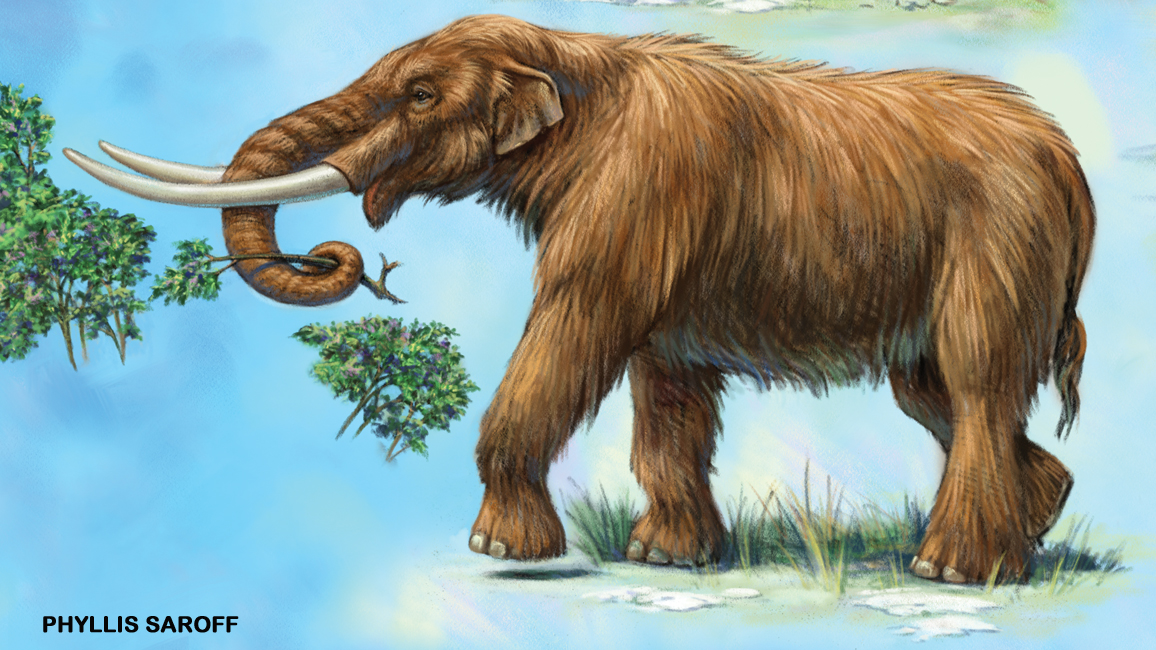
Meet the Ice Age Giants
By Anne Cissel; Art by Phyllis SaroffThousands of years ago, enormous mammals roamed a chilly North America.

IF YOU’VE SEEN the “Ice Age” movies, you may know a surprising amount about that time in Earth’s history. The films get a lot correct! Slabs of ice—some more than a mile thick—covered much of the northern part of the globe and portions of the southern part. In places where plants could grow, mammoths, giant ground sloths, and lots of other huge, now-extinct animals ruled the land.
OK, OK—these creatures didn’t talk or go on adventures together as in the movies. So, what were they really like? And what happened to them? Let’s go back in time and take a tour of North America during the Ice Age!
TOOTHY KITTY
Imagine walking in the woods and spotting a wild cat crouching in the tall grass—a cat bigger than an African lion! This cat, Smilodon (SMYluh-don), is often called the “saber-toothed tiger.” But it wasn’t closely related to tigers. Its two front teeth WERE like sabers (long, curved, sharp swords) and had saw-like edges. Its back legs were built for jumping. Its front legs were very strong and were used to hold down prey. Other big cats, such as American lions and American cheetahs, also prowled around North America during the Ice Age.
ICE AGE FACTS
• An ice age is a period of millions of years when the Earth is very cold. During an ice age, much of the Earth’s water is frozen in giant ice sheets.
• There have been five ice ages in Earth’s history. Within each ice age are glacials (GLAY-shulls), periods of time that are extra cold.
• The last glacial started about 126,000 years ago and ended about 11,000 years ago. It is common to call that time period the “Ice Age.” The animals in this story lived then.

MAMMOTHS VS. MASTODONS
Maybe the most famous animal from the Ice Age is the woolly mammoth. It lived in the coldest parts of North America. Its body was built for cold weather. Long fur and a thick layer of fat kept it warm. Farther south, the Columbian mammoth lived all over what is now the United States. All mammoths are closely related to elephants that live today.
It’s easy to confuse the mammoth with the American mastodon, another hairy elephant lookalike that lived during the Ice Age. But while the modern-day elephant and the mammoth are fairly closely related, the mastodon is a distant cousin. But mammoths and mastodons did have a common enemy: humans. Fossils show clues that some mammoths and mastodons were killed with spears!
CAR-MADILLO
If you were a plant-eating animal during the Ice Age, being large would help protect you from big predators. Glyptotherium (glip-toh-THEER-ee-um) is related to a modern-day armadillo. But it was the size of a small car! It also had a bony covering, similar to a turtle’s shell. This massive armadillo had a muscular tail covered with bony knobs to swing around for protection. Even so, meat-eating animals still found ways to make meals of these tough giants. A fossil of a Glyptotherium’s skull found in Arizona had a bite mark from a cat related to Smilodon!

TALL BEAR
The polar bear is the largest bear in the world these days. Thousands of years ago, the giant short-faced bear won the size prize. In fact, it is the largest meat-eating land mammal that ever lived in North America. This bear is called “short-faced” because its snout is shorter than the snouts of most modern bears. But the rest of it is much bigger!
One scientist called this Ice Age bear a “grizzly on stilts” because of its long legs. Standing on all fours, it was tall enough to look a human in the eye. Up on its hind legs, it would be as tall as a basketball hoop!
SURPRISING SLOTH
One of the strangest mammals of the Ice Age was also one of the largest: the giant ground sloth. The biggest one in North America weighed as much as six cows—more than 7,500 pounds. But unlike a cow, it could stand on two legs. At that height, it was as tall as a giraffe! The giant ground sloth was certainly too heavy to climb trees as modern-day sloths do. It ate plants on the ground or stood against trees to reach higher-up leaves. Scientists believe that it might have had a tongue like a giraffe’s, able to grab leaves and tear them off branches.
SOME GO, SOME STAY
Why don’t giant sloths and mammoths live in our wild places anymore? It’s a mystery that scientists are trying to solve. As the ice started to melt and the Earth warmed up, most large mammals went extinct. Many scientists think that the animals weren’t able to adapt to the changes in the Earth’s climate. Some think that early humans hunted too many of the big animals.
A few large mammals that exist today—such as bison, caribou, and musk oxen—also lived during the Ice Age. Some small mammals, including the American pika, outlasted the Ice Age, too. YOU have something in common with these animals. People also survived the Ice Age!
















